Using the image editor
The Actito image editor directly integrated into the email editor is an all-in-one tool that allowing you to take the personalization of your communications one step further.
By offering you the possibility of modifying your images directly from the email editor, you save precious time by avoiding recourse to external tools. Moreover, this feature allows you to ensure visual consistency in your campaigns by personalizing your images when creating your content.
The Actito image editor offers you a wide range of options for personalizing your images, allowing you to annotate, crop, apply filters and much more.
To edit the images contained in your email, in the editor, move your mouse over the image you wish to edit and click on 'Edit image'. An editing menu will open
![]()
The editing menu is only available for uploaded photos. If you wish to edit an image from your DAM library, be sure to save it on your computer before uploading it to the content of your e-mail to be able to edit it.
From this menu, you will have access to various tabs that let you scale, resize, apply filters and more.
Browsing the Image Editor
In the upper part of the editing menu window, you will find a permanent menu, allowing you to scale, resize, apply filters and much more.
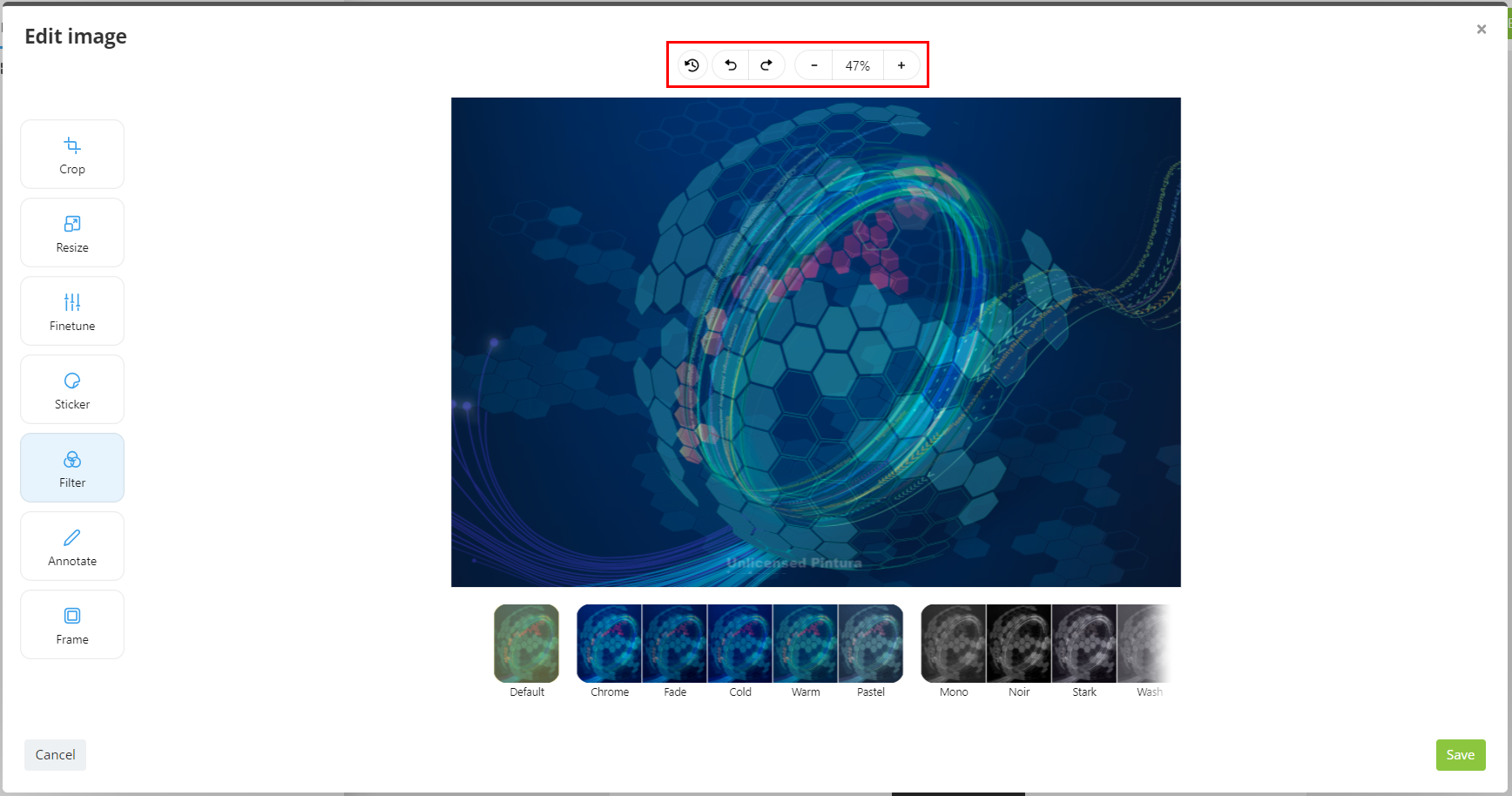
Thanks to this menu, you can :
- Restore the original image before any modification
- Undo last modification
- Restore last modification that was undone
- Zoom in/out on your image to get a more precise or general view of the modifications you have made.
The zoom function is not available for the 'Crop' and 'Rezise' tabs.
Please note that once the image is saved, it will no longer be possible to restore the original image. As soon as you save your changes, the modified image is saved and the editing menu closes. If you reopen the editing menu, you will not be able to undo or restore any previously saved modifications. The modified image then becomes the base image. You can, however, return to the base image via the session history.
Crop tab
In this tab, you can rotate and crop your image.
You have either the possibility to use the predefined setting, using the buttons above your image, or freely rotate and scale your image using the slider, located below the image.
To do so, select the 'Rotation' or 'Scale' function and then drag the progress bar to the right or left to define your angle of rotation or degree of scaling.
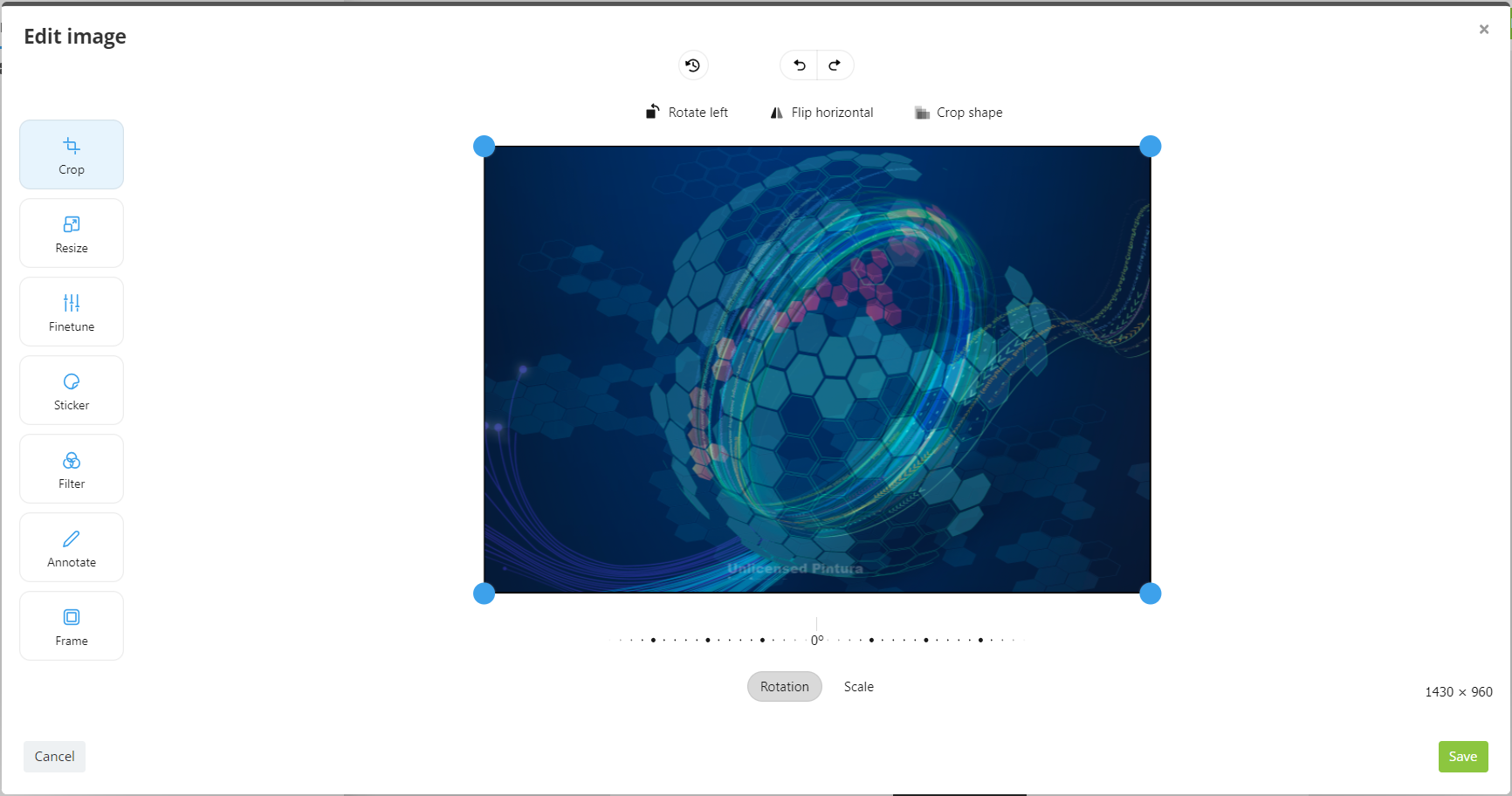
The option 'crop shape' allows you to crop your image to standard or customized shape and size.
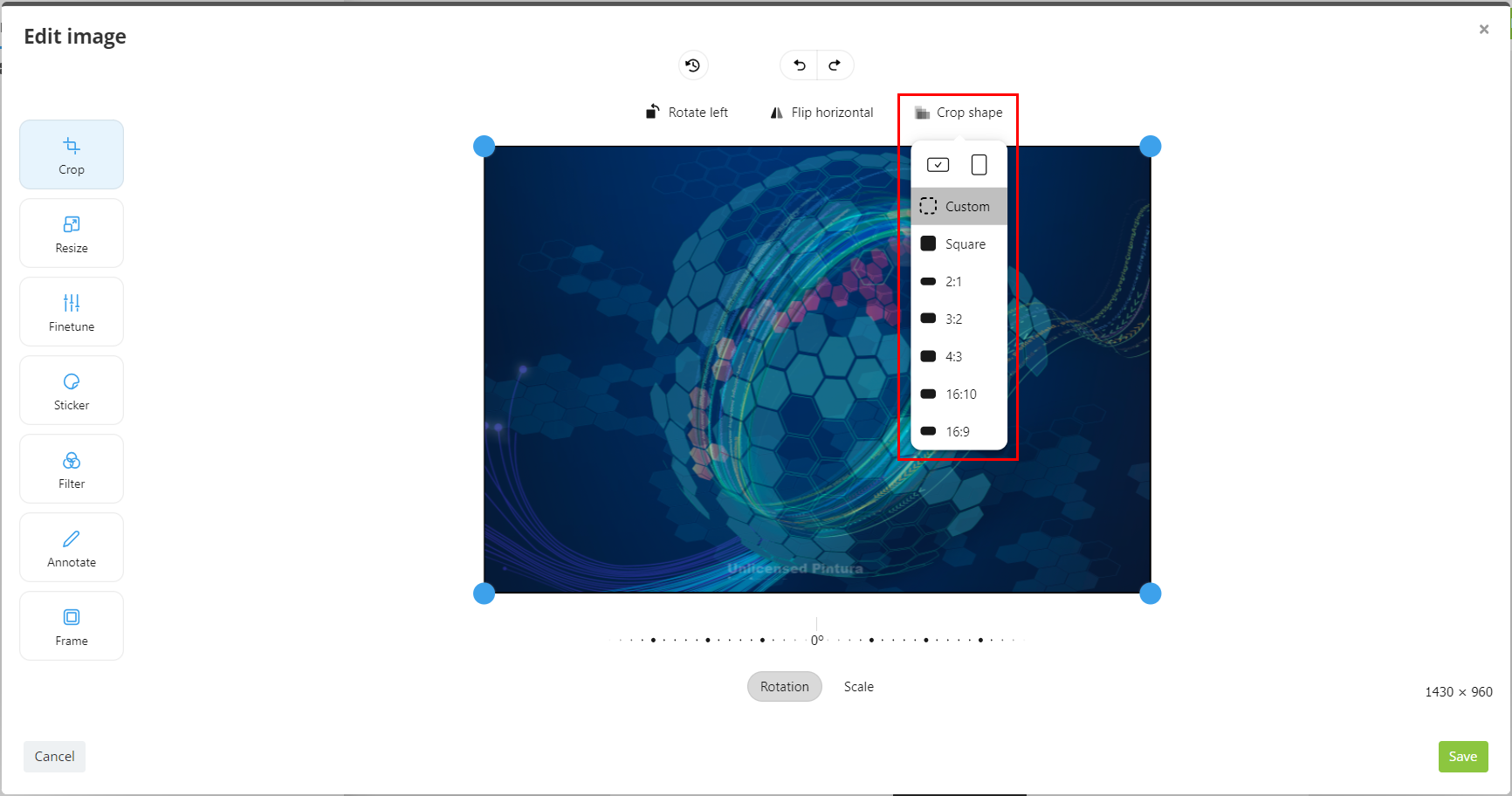
Resize tab
This tab allows you resize your image by defining its height and width in pixels.

The padlock icon allows you lock or unlock the aspect ratio of your image.
Finetune tab
This tab allows you modify the brightness, contrast, saturation and other parameters of your image.
To adjust any of these parameters, select the one you wish to adjust from the various adjustment options below your image and drag the progress bar to the right or left to modify your image.

Sticker tab
This tab allows you add stickers to your image.
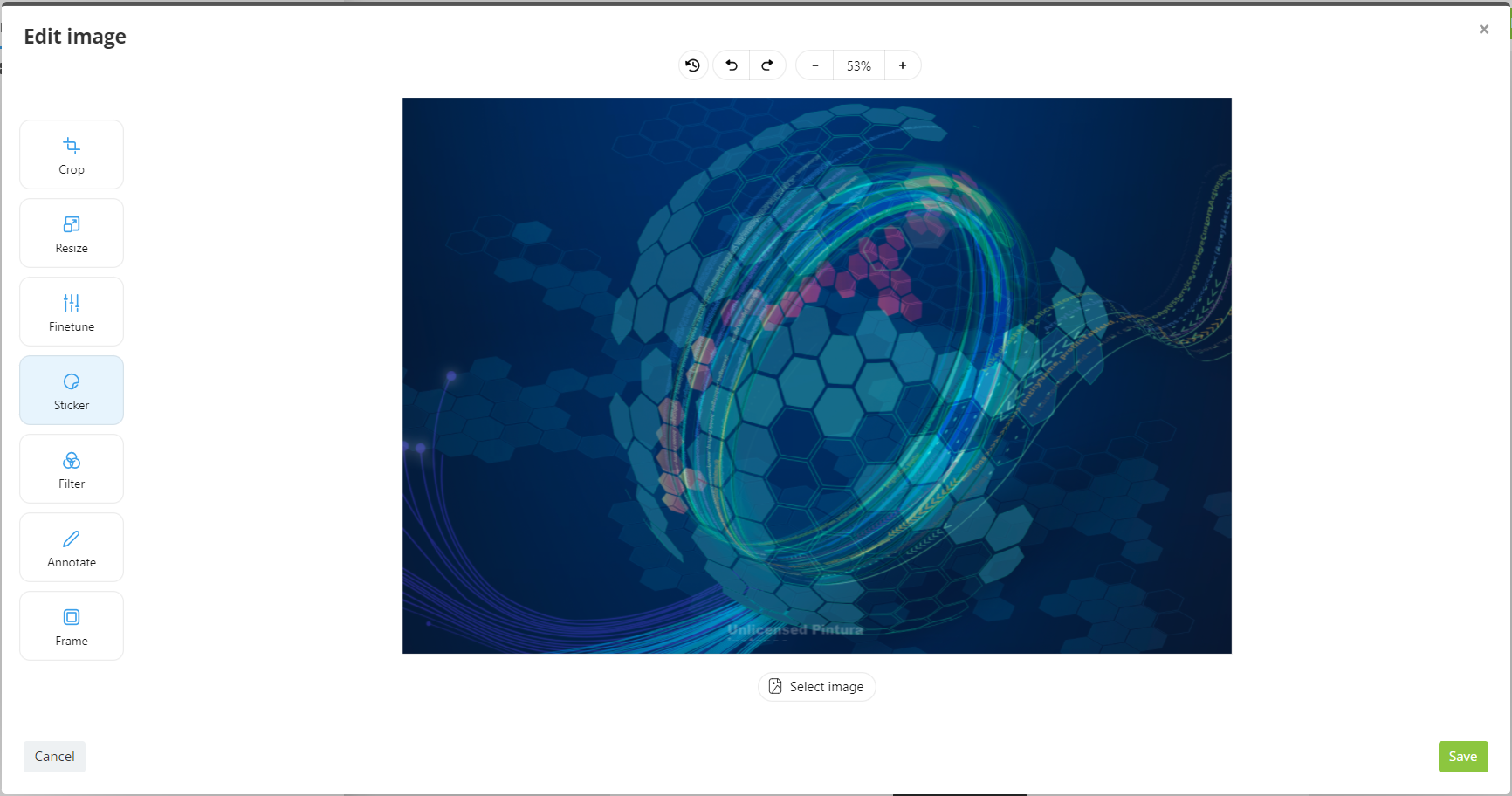
To do so, click on 'Select image'. A file explorer window will open, from which you can select the image you wish to add as a sticker from the ones stored locally on your computer.
It will then be added to your first image. You can move your sticker freely, reduce its opacity (by default it is set to100%), reduce or increase its size, flip it horizontally, delete it and copy it.
You can add multiple stickers to your image and control their visual overlapping hierarchy by determining which elements should appear in the foreground.
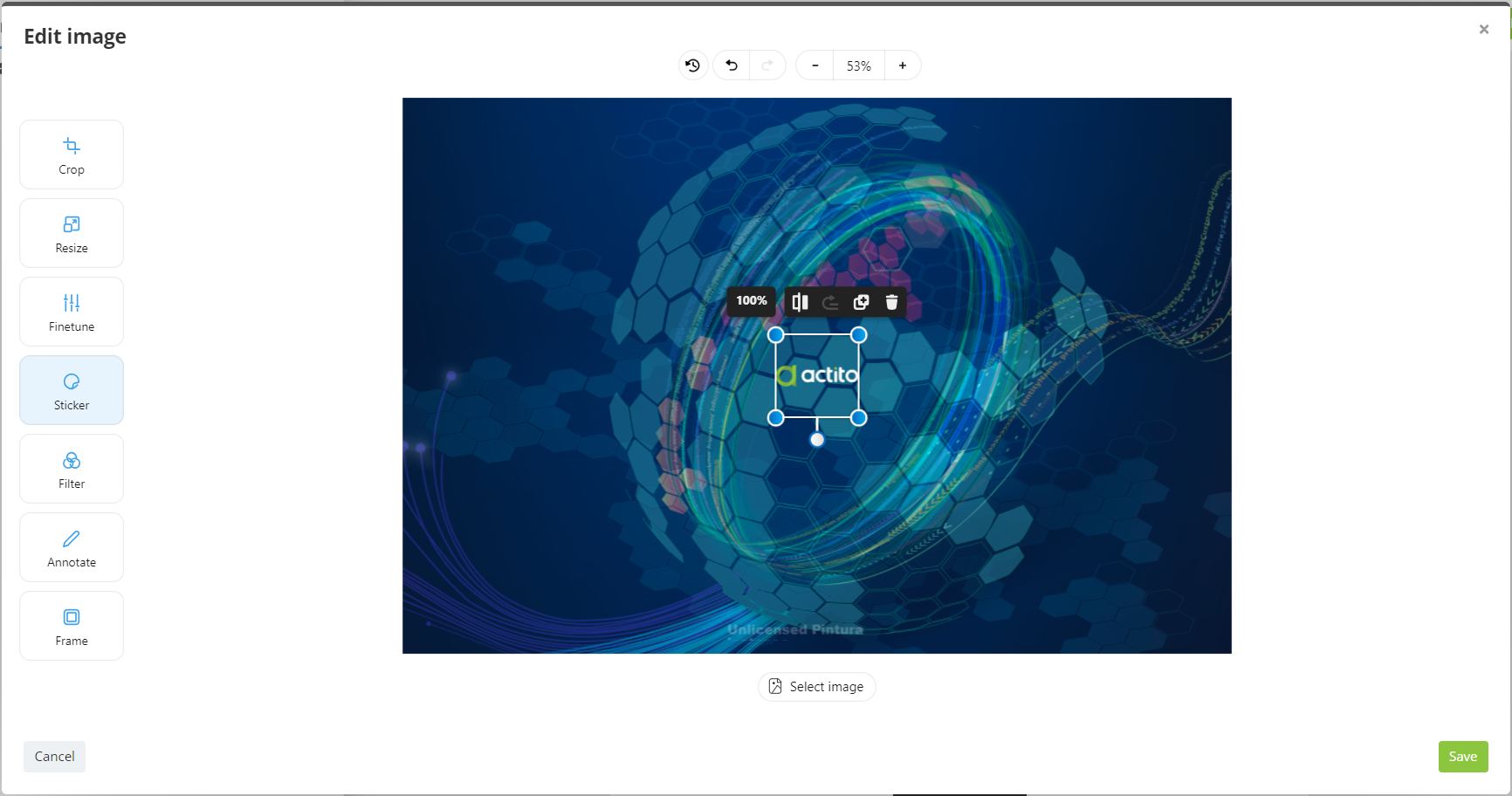
Filter tab
This tab allows you apply different predefined filters to your image.
To apply a filter, simply select the filter you want to apply from the list of filters available below the image.

Annotate tab
This tab allows you annotate your image using several tools:
For each of the annotations added to your image, you have the option of bringing them to the foreground and deleting them.
Sharpie
This object allows you draw free-form shapes to your image.
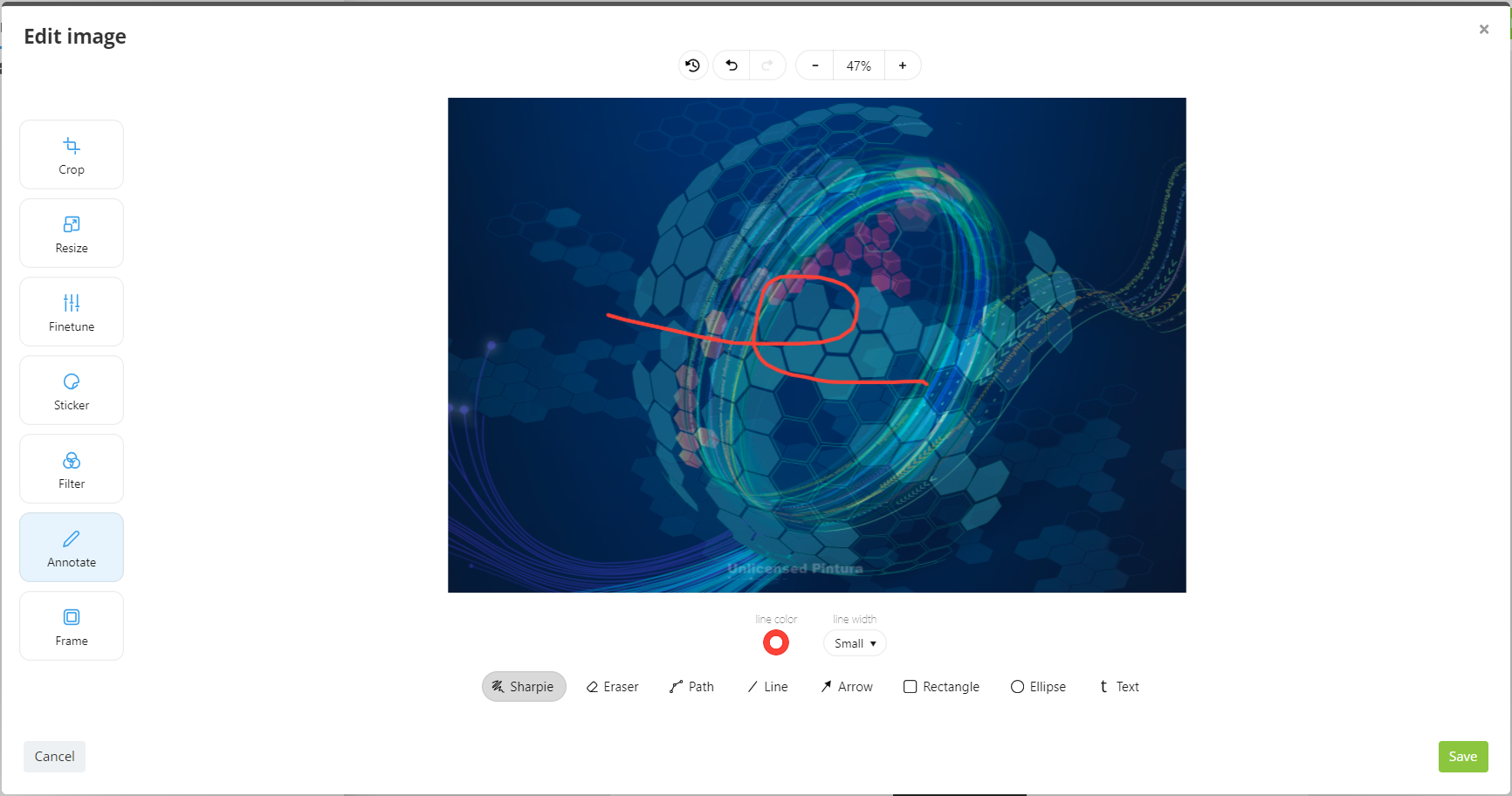
You can choose the line thickness and color of your sharpie.
Eraser
The eraser function allows you delete any annotation you create, whether it is a shape or a free drawing.
If you use the erase function on an annotation, the entire annotation will be deleted.
Path
The path function allows you create custom shapes, drawing curved or straight lines by manipulating vector paths.
For each of your paths, you can define the outline color and the fill color of the shapes you create. You can also decide to leave the fill color empty, according to your own preferences.
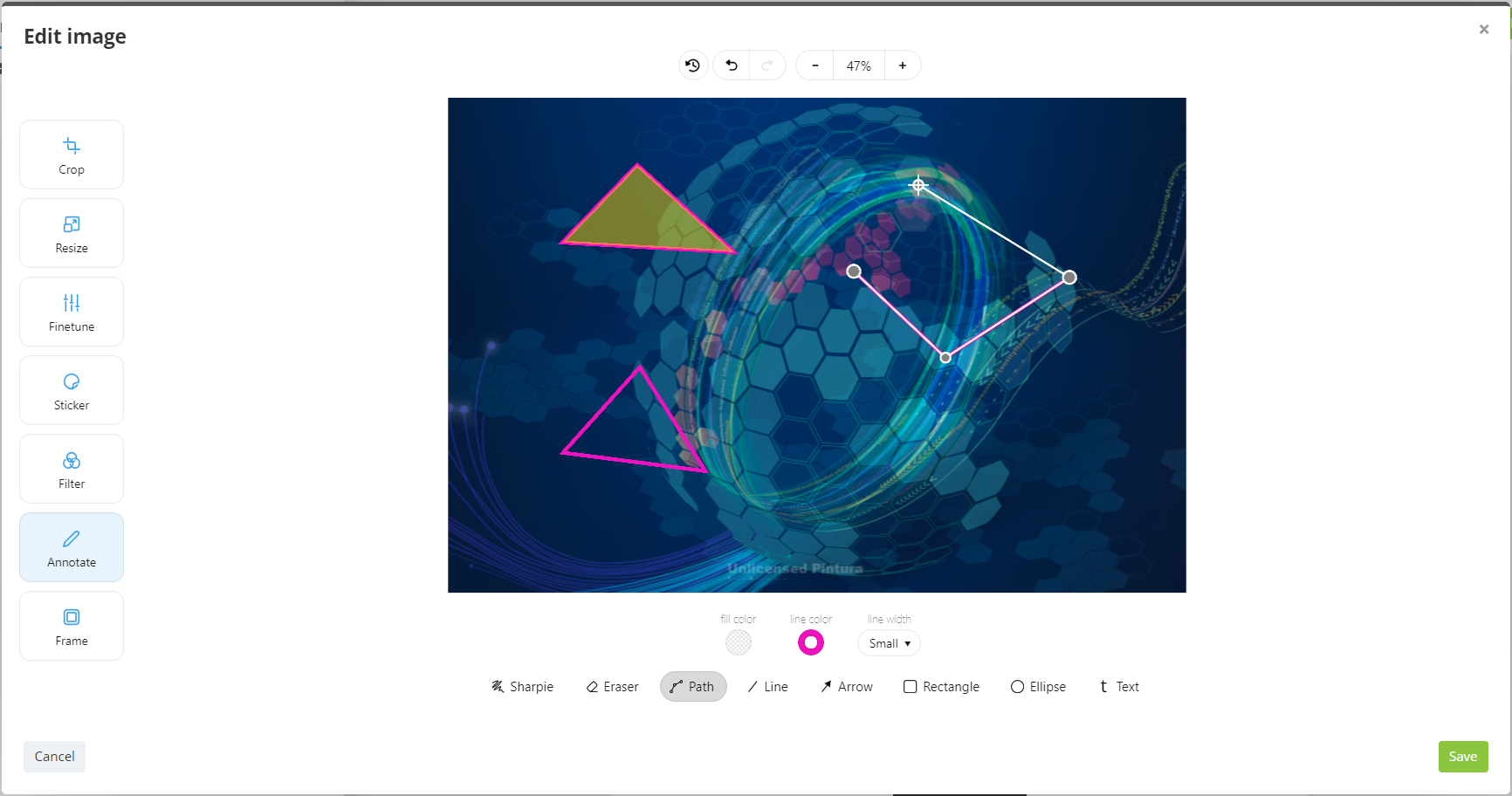
Line and Arrow
The 'Line' and 'Arrow' functions in the Edit menu allow you to draw lines and arrows on your image.
For each function, you can choose the line color and thickness, as well as the start and end shape of your line/arrow (by default, for the line function, the start and end shapes are none, and for arrows, the start shape is none and the end shape is an arrow).
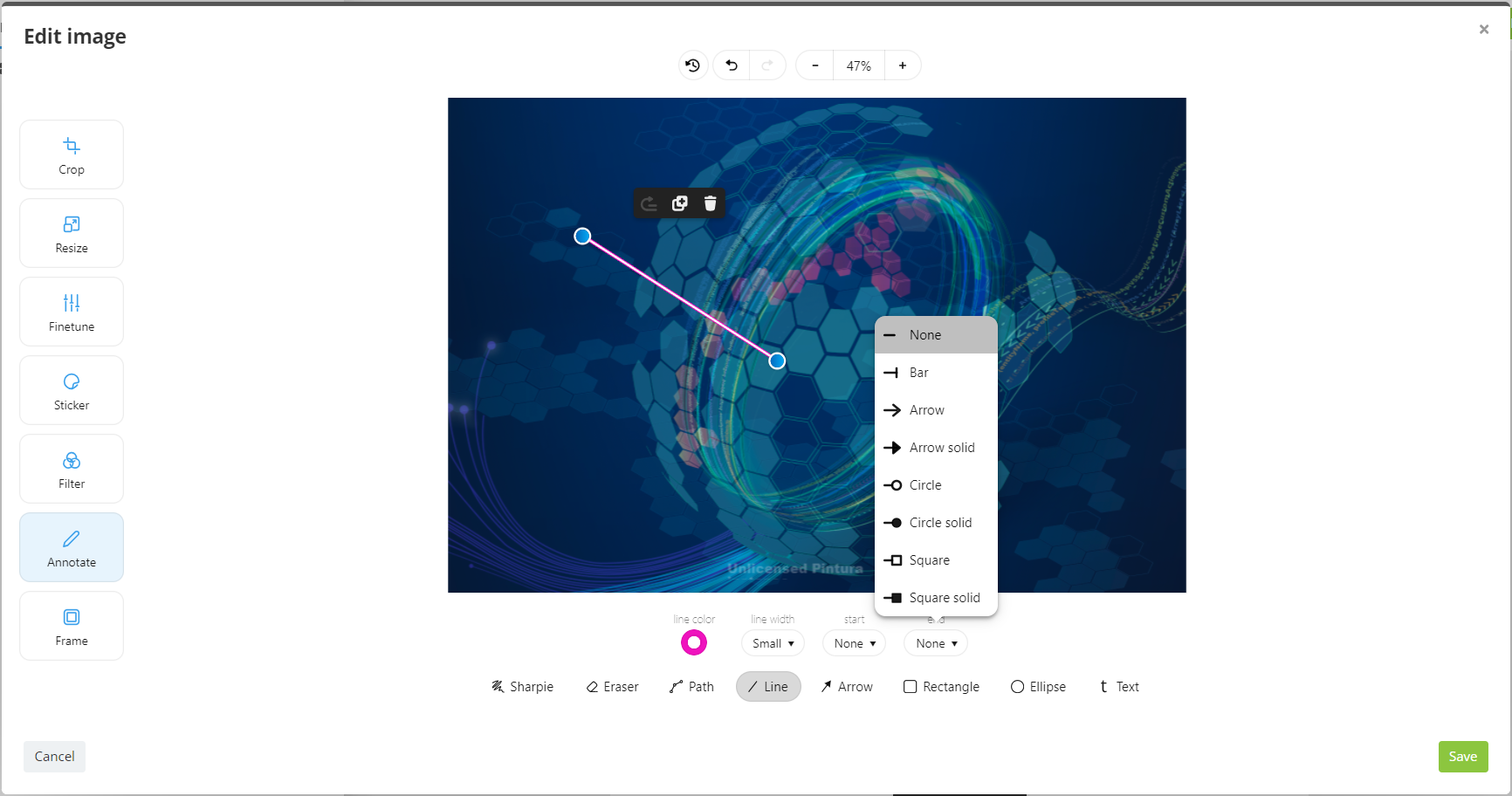
Rectangle and Ellipse
The 'Rectangle' and 'Ellipse' functions let you add shapes to your image. For each of these functions, you can define the fill color (if you wish to fill the shape), the shape outline color and thickness (if you wish to outline your shape) and, for the 'Rectangle' function, the corner radius (which allows you to round the corners of your shape from 0 to 100%).
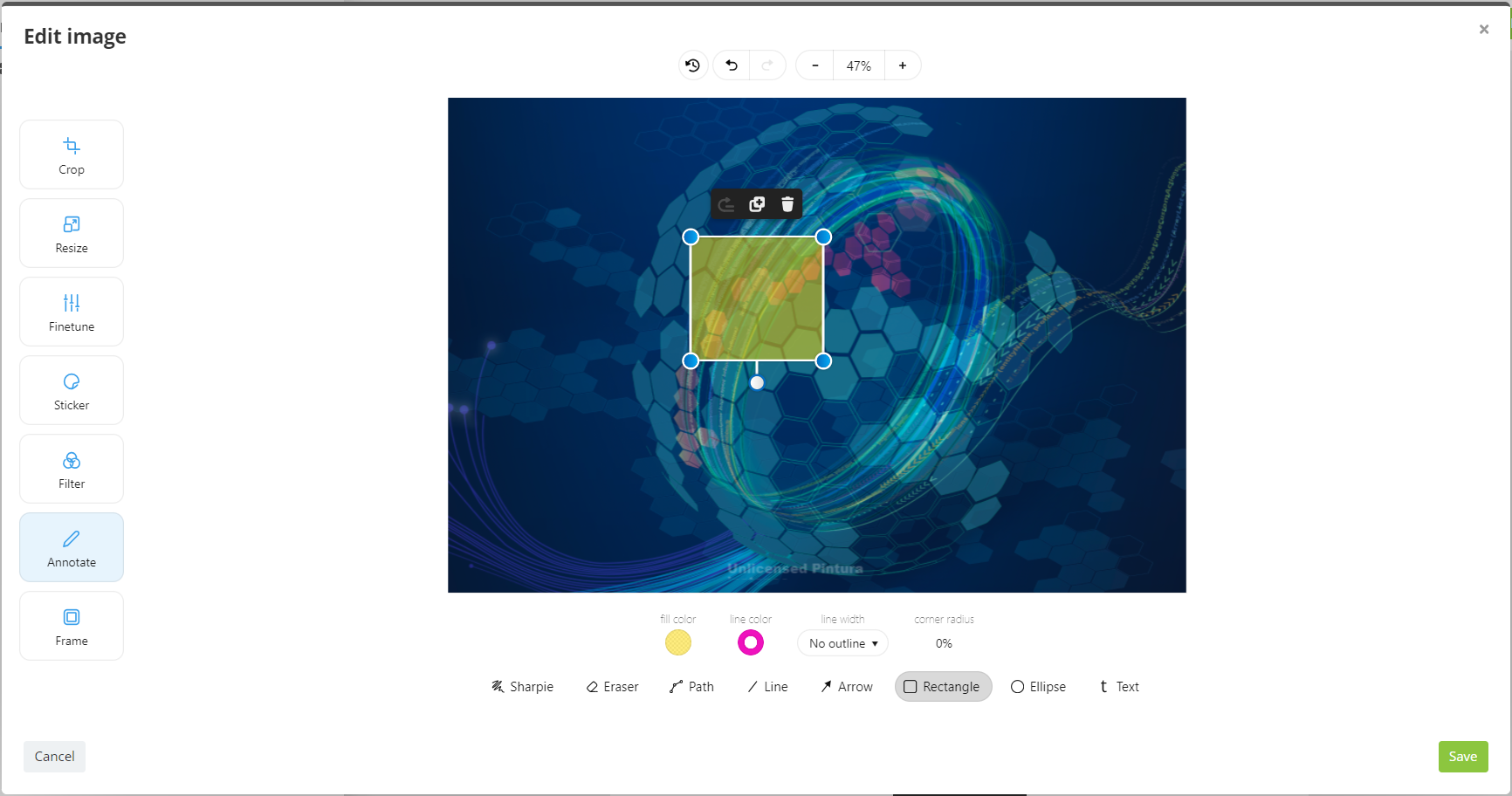
Text
The text function allows you to insert a text zone on your image.
In this tab, you will find a text editor that allows you to format the added text:
- Text color
- Font: allows you to choose the font from: 'Sans Serif', 'Black', 'Narrow', 'Humanist', 'Serif', 'Old-Style', 'Transitional', 'Monospaced' and 'Slab Serif'.
- Font style: allows you to format your text. The style will be applied to all text in the formatted area.
- Font size: allows you to choose the size of your font, allowing you to have text from 'Extra small' to 'Extra large'.
- Line height: allows you to choose the size of your line spacing, from 'Extra small' to 'Extra large'.
- Text align: allows you to align your text left, center or right
- Zone width and height: when you create your text zone, you can draw it with any height and width you like. Once your text is written, the icon in the center of your text zone menu allows you reduce the height, width or both height and width of the zone in relation to the size of the text. You can also leave the zone as you created it.
- Edit text: allows you modify the text you have written.
If you want to delete a text zone, you must use the eraser or the delete option. Erasing the text inside the zone will not delete the text zone.
Frame tab
This tab allows you to add a frame to your image. To do so, simply select the frame you wish to add from the various proposals below your image.
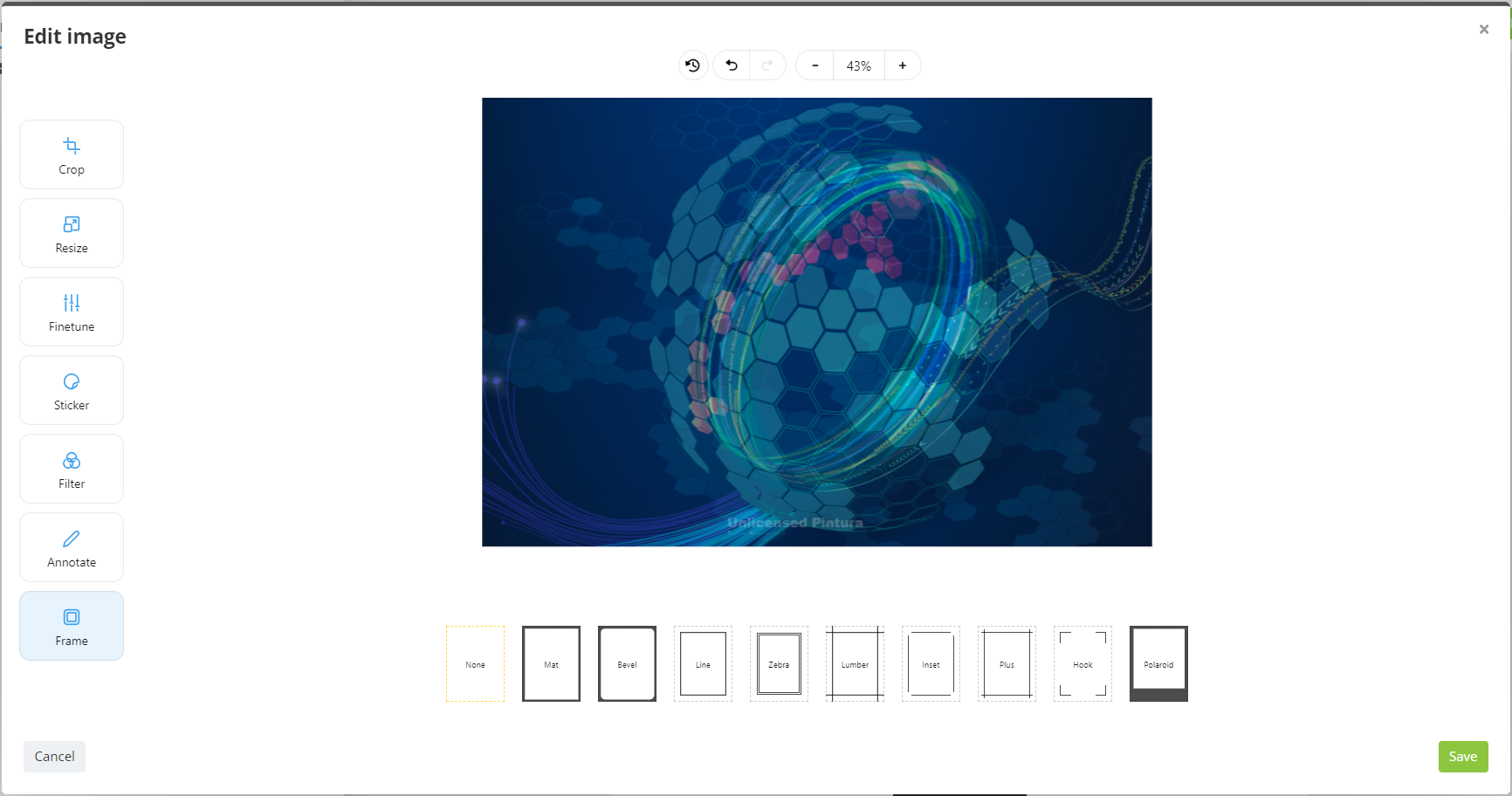
Then, depending on the frame you select, several different settings are available:

- Color: allows you to define the color of the frame. You can select a color from a color palette or freely from a color chart. You can also set the opacity of the chosen color.
- Size: allows you to define the thickness of your frame's lines. The default setting is 3%.
- Offset: allows you to define the size of your frame. The higher the value, the smaller and more centered the frame will be on your image. The default setting is 25%. The second offset setting lets you define the spacing between each frame (if there are several frames on the image).
- Radius: allows you to define the degree to which the corners of your frame are rounded.
- Amount: allows you to define the number of frames to be placed on your image (from 1 frame to 5).
Save your image
Once you have made all the changes and adjustments you wanted to make to your image, click on the 'Save' button for your changes to be taken into account.
Once you have saved your image, you cannot go backwards. The image thus saved becomes your base image if you wish to make further modifications. You can, however, return to the base image via the session history.
Test your image
Some transformations, such as enlarging your image or adding elements, can increase the weight of your image.
Be sure to send a test e-mail after editing an image to ensure that the e-mail still respects the weight limit.